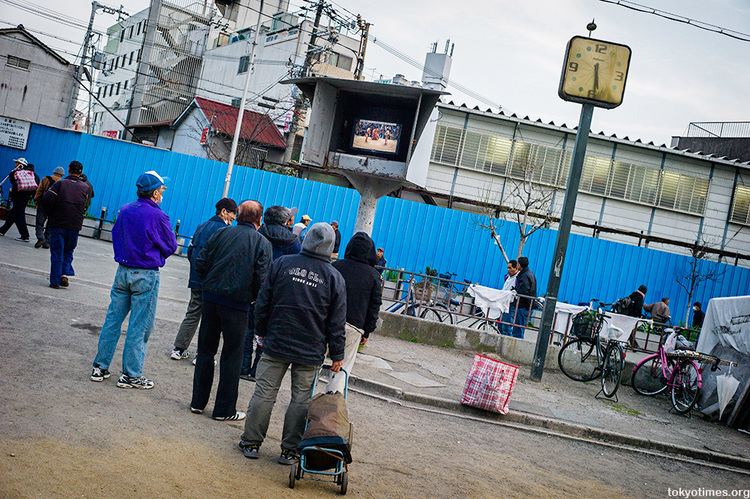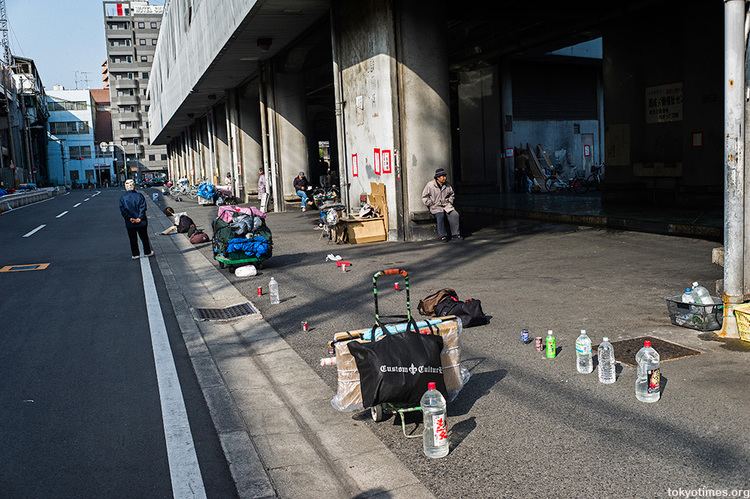 | ||
Kamagasaki
Kamagasaki (釜ヶ崎) is an old place name for a part of Nishinari-ku in Osaka, Japan. Airin-chiku (あいりん地区) became the area's official name in May 1966.
Contents
- Kamagasaki
- Kamagasaki the biggest slum in japan vol1
- Geography
- Transport
- History
- Notable riotshuman rights protests
- Education
- Welfare
- Peace Institutions
- Events
- References

Kamagasaki the biggest slum in japan vol1
Geography
Sections of four different towns — Nishinari-ku Taishi (西成区太子), Haginochaya (萩之茶屋), Sannō (山王), North Hanazono (花園北) and Tengachaya (天下茶屋) — are collectively known as Kamagasaki.
Transport
History
Kamagasaki has been a place name since 1922. An accurate count of occupants has never been produced, even in the national census, due to the large population of day laborers who lack permanent addresses. Daily life in Kamagasaki in the 1950s was photographed by Seiryū Inoue, who won the 1961 Newcomer's Prize awarded by the Japan Photography Critics` Society for "One Hundred Faces of Kamagasaki". It has the largest day laborer concentration in the country. 30,000 people are estimated to live in every 2,000 meter radius in this area, part of which has been in slum-like conditions until as recently as 2012, containing run-down housing structures and untidy streets.

The area surrounding Kamagasaki is upscale, clean and attracts tourists with popular sightseeing spots including the Tsutenkaku, Shinsekai, and Nipponbashi. However, in Kamagasaki, homeless people can often be seen sleeping in the streets throughout the day, and doya (ドヤ) hotels (cheap temporary rooms intended for day laborers) abound in the area. These hotels have recently become popular amongst backpackers from outside Japan due to their cheap price and close location to rail transportation.

Non-profit and religious organizations frequently give out food rations, creating long lines of people in public parks. Property values in Kamagasaki are noticeably lower than those of surrounding areas.
The city government of Osaka does not allow the name "Kamagasaki" to appear on official maps and discourages the use of the name in the media. A film set in the neighborhood by director Shingo Ota which was partially financed by the city, called "Fragile", was pulled from the 2013-2014 Osaka Asian Film Festival after Ota refused to cut scenes from the film that identified the location of the community and referenced certain aspects of its culture.
Notable riots/human rights protests
Several conflicts with the police have occurred in Kamagasaki since 1961 over perceived human rights violations by authorities. The mass media usually refer to these events using words that can be translated as "riot".
The first riot occurred on August 1, 1961, when an elderly day laborer from Kamagasaki was killed in a traffic accident. The official who arrived on the scene assumed that the man was already dead (only doctors are allowed to pronounce a death) and left the body on the street for over 20 minutes without calling an ambulance while he spoke with witnesses. A large group of day laborers surrounded the Nishinari police station in protest of the man's treatment, overturned parked police cars, and set fire to nearby apartment buildings. The Osaka Prefectural Police responded with 6,000 officers, using police sticks and vehicles to round up the rioters. It took two days to stop the 2,000 rioters; 28 were arrested. Approximately 10 rioters and 100 police officers were injured.
This riot became a national issue and was taken up in the prefectural legislature and national legislature of Japan. Several attempts were made to mend relationships between the groups, but minor riots continued to occur. In May 1966, it was decided that the official name of Kamagasaki would be changed to Airin-chiku (あいりん地区) in an attempt to improve the area's crime-ridden image. The name Kamagasaki is still commonly used amongst inhabitants, while the name Airin-chiku is used by the media and government officials.
The 22nd riot occurred in October 1990, 17 years after the last riot in 1973. This riot also involved local day laborers but grew in proportion when youths from outside Kamagasaki joined in. Shin-Imamiya Station and local stores were set on fire during this riot, and it took several days to calm the area.
The 23rd riot occurred in October 1992, and a large-scale riot did not occur for over 10 years. This was the last large-scale riot to occur in Japan before the 34th G8 summit.
The 24th conflict with the police occurred on June 13, 2008, and it continued six days. It was related to the 34th G8 summit. One day before the G8 Finance Ministers' Meeting started in Osaka with a very large police presence, a day laborer in Kamagasaki was allegedly tortured by the police. In protest, many day laborers and other local citizens carried out several days of street protests. Many mass media referred to the protests as a "riot".
Education
Nursery school: Wakakusa Nursery School, 2-9-2 Haginochaya
Primary schools: Haginochaya Primary School, 1-11-15 Haginochaya; Koji Primary School, 2-16-26 Hanazonokita
In 1962 Airin School (renamed to Airin Elementary and Junior High School the next year) was founded. (In 1973, it was renamed Osaka City Shin-Imamiya Elementary and Junior High School. It closed in 1984.) The requirements of entering is not having register or resident registration.
Junior high school: Imamiya Junior High School, 1-8-32 Hanazonokita
Other school: UNION Theology University Extension Study, 3-4-23 Haginochaya
Welfare
The number of people who receive Life Protection is the highest in Japan (176 people per 1,000). The city of Tokyo is 17, Nagoya is 13, Fukuoka is 19, Osaka City is 42.
The percentage of people who receive school attendance is 50.4% (whole of Japan is 13.7%, Osaka-fu is 24.7%, Osaka City is 33.8%).
Peace Institutions
Events
Memorial service at the 38th Kamagasaki Summer Festival
The 28th Twilight Concert
